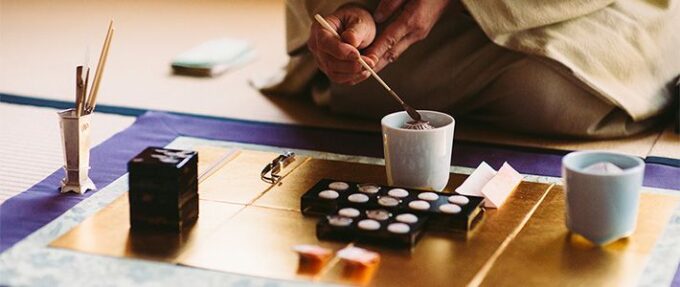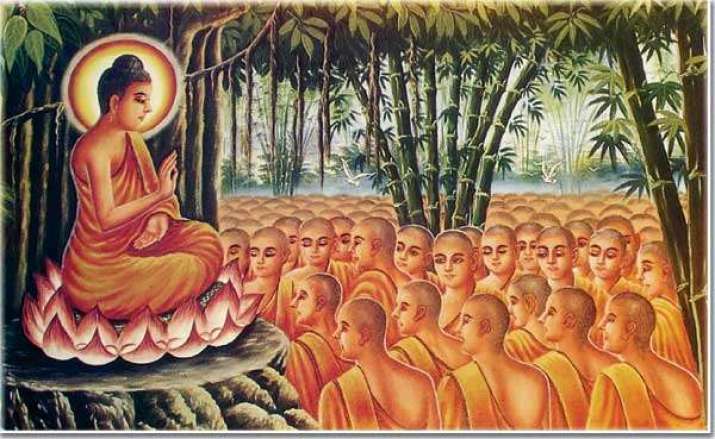Kōdō (“Way of Fragrance”) is counted as one of the classical Japanese arts of refinement, along with chadō (“The Way of Tea”), kadō (“The Way of Flowers”) and shodō (“The Way of Calligraphy”). Kōdō art takes many years of study and a great deal of practice in order to perform the incense ceremony properly. It is said that the art of Kōdō takes over 30 years to master. Becoming able to break down a given fragrance into different elements needs a lot of experience and a very refined sense of smell.
The word kō means “fragrance” or “incense”. The word dō means “way” and in this context, “ceremony”. Kōdō includes all aspects of the incense process, from the tools (kōdōgu), to activities such the incense-comparing games in which players must distinguish and differentiate various types of incense. The best-known game is the jusshûkô, or “Ten round incense game.” In this game, different incense was passed around ten times.
Kōdō consists of two main elements: Monkō and Kumikō. Monkō is a practice just to enjoy and appreciate together the scent given off by burning the fragrant wood. Kumikō is a practice to tell the name of odors by distinguishing the type of scented wood.
The fragrances of kōdō are divided into rikkoku gomi (lit. six countries, five tastes). The rikkoku are six kinds of fragrant wood: kyara, rakoku, manaka, manaban, sumatora, and sasora. The gomi are the tastes of amai (sweet), nigai (bitter), karai (spicy hot), suppai (sour), shio karai (salty). Incense utensils or equipment is called kōdōgu. Different styles and motifs are used for different events and in different seasons. All the tools for incense ceremony are handled with care and scrupulously cleaned before and after each use and before storing. The main elements of the ceremony are censer bowl, white ash, charcoal, ash press, mica plates, metal chopsticks, metal tongs, etc.
Traditionally, the ceremony is conducted in a Japanese-style tatami room and performed in a complete silence. The optimal number of participants for an incense ceremony is ten guests, with the honorary guest seated to the left of the kōmoto (the incense presenter) as the first recipient of the kōdō cup. The process of sniffing incense is a specific one. The participant needs to steady the incense burner on the left hand and keep it horizontal placing the right thumb and little finger on the incense burner. Then, he has to bring the burner up to the nose while keeping it horizontal, then to take in the fragrance through the space between the right thumb and forefinger.
When practicing kōdō, is not possible to light the incense directly. Instead, ash and solid fuel (such as charcoal), is placed into a small censer bowl, and then a little mica plate is put upon them. Tiny chips of wood from aromatic trees are then heated atop the mica plate. Because the wood is not actually burned, it gives off its fragrance in a subtle way. The materials used for this incense can also include plants, shells, spices, and so on. The secret of kōdō is in “listening.” The participants don’t “smell” the incense or fragrant wood, but rather “listen” to it.
Kōdō was formalized around the time of the shogun Ashikaga Yoshimasa (1443-1490), who asked the scholar Sanjonishi Sanetaka to classify all of the incense that were in use at the time. For this reason, Sanjonishi is considered to be the “father” of kōdō.
Incense wood was recorded for the first time in Japan in 595, during the reign of Empress Suiko. Not long before that date, in the mid-sixth century, Buddhism had been introduced into Japan from the continent, and along with Buddhist images and sutras, incense and its implements were also imported. From the end of the Nara period (710–784), courtiers inspired by the use of incense in Buddhist rituals in temple settings also began to burn incense in their homes. The incense they used was kneaded and mixed into balls, which served not only to “perfume” the air of the rooms, but also—as an indicator of refined taste—to perfume clothes and hair.
By the time of the establishment of the Kamakura shogunate in the twelfth century, the Zen school – a new approach to Buddhism – had been introduced from China. It was through the introduction of this new approach that a new way of appreciating incense developed among aristocratic warriors.
During the Muromachi period (1392–1573), the etiquette of “the way of incense” developed in tandem with the tea ceremony. With the Meiji reforms (1867–68) and the “westernization” of Japanese culture in the second half of the nineteenth century, the practice of incense became obsolete. However, from the 1890s, partially due to foreign efforts to revalue Japanese culture, appreciation of “the way of incense” was gradually reborn.
Photo credit: lasendaweb




